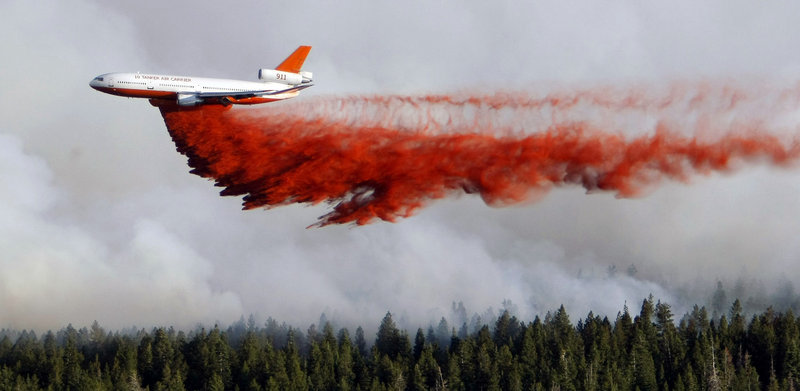DENVER — Air Force tanker planes returned to the flight line for firefighting missions on Tuesday after a deadly weekend crash, bringing much-needed reinforcements to a strained fleet battling some of the worst wildfires in decades.
The return of five C-130s means wildfire managers now have 19 heavy tankers to battle the huge fires that have burned hundreds of square miles and displaced thousands of people across the West.
One wildfire in Montana has charred more than 290 square miles and burned 16 homes. The fire was 55 percent contained.
The most active part of the fire was burning thick, largely inaccessible timber in the Custer National Forest. That has led firefighters to steer clear of the dangerous forward edge of the blaze, fire information officer Kathy Bushnell said.
In Wyoming, erratic winds have spread a wildfire across 128 square miles in a sparsely populated area since it started June 27. It was only 10 percent contained.
“We’ve had this fire push north, push south, push east and push west at various times,” fire spokesman Jim Whittington said.
The Air Force had sidelined its seven remaining firefighting C-130s to review safety procedures after a C-130 from the North Carolina National Guard crashed Sunday, killing four crew members.
The plane was helping fight a wildfire in the Black Hills of South Dakota.
The cause of the crash is under investigation.
The National Guard identified the dead as Lt. Col. Paul K. Mikeal, 42, and Maj. Joseph M. McCormick, 36, both pilots; Maj. Ryan S. David, 35, a navigator; and Senior Master Sgt. Robert S. Cannon, 50, a flight engineer. All were from North Carolina and were assigned to the 145th Airlift Wing.
The names and conditions of the two injured crew members were not released.
Five of the remaining C-130s were ready to fly firefighting sorties from Peterson Air Force Base in Colorado Springs on Tuesday. A sixth was expected to be available today. None had been sent on any missions by Tuesday afternoon.
The seventh, which was also assigned to the North Carolina Air National Guard, returned to its home base in Charlotte.
Meanwhile, the U.S. Forest Service hoped to add three “next-generation tankers” – British-made BAe-146 aircraft – to its fleet of fire-suppressing aircraft by August, with another four similar aircraft due to be available by the summer of 2013, said spokeswoman Jennifer Jones in Boise.
The decision to suspend the Air Force’s C-130 flights left just 14 federally contracted heavy tankers in use during one of the most destructive wildfire seasons ever to hit the West.
The National Interagency Fire Center in Boise, Idaho, which coordinates wildfire-fighting efforts nationwide, said 45 large fires were burning Tuesday, including 36 fires in nine Western states. In Colorado alone, three fires have destroyed more than 600 homes and killed six residents.
Send questions/comments to the editors.



Success. Please wait for the page to reload. If the page does not reload within 5 seconds, please refresh the page.
Enter your email and password to access comments.
Hi, to comment on stories you must . This profile is in addition to your subscription and website login.
Already have a commenting profile? .
Invalid username/password.
Please check your email to confirm and complete your registration.
Only subscribers are eligible to post comments. Please subscribe or login first for digital access. Here’s why.
Use the form below to reset your password. When you've submitted your account email, we will send an email with a reset code.